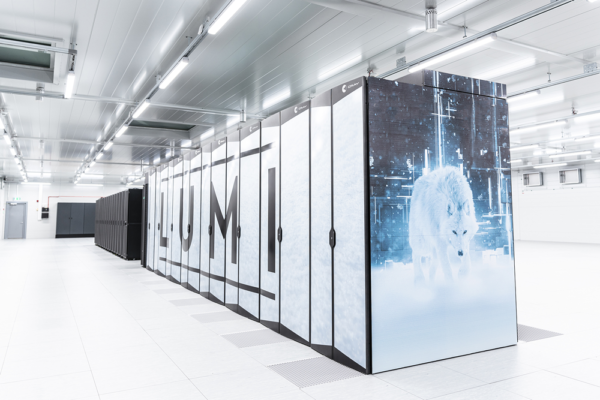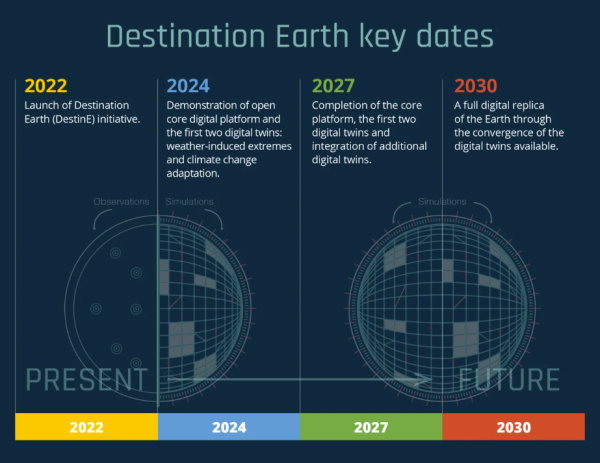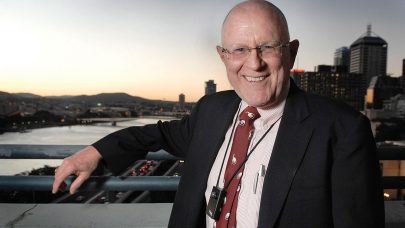In late 2020, the European Union announced plans for its Destination Earth (“DestinE”) moonshot project to create multiple digital twins of Earth, including one digital twin for extreme natural disasters and another for climate change adaptation. DestinE, orchestrated by institutions like the European Centre for Medium-Range Weather Forecasting (ECMWF), the European Space Agency (ESA) and the European Organisation for the Exploitation of Meteorological Satellites (EUMETSAT), officially launched in March of this year – a bit of a delay from the EU’s original plans for a 2021 launch. Now, the leading partners of DestinE are announcing new developments as the collaboration truly gets underway.
ECMWF – which is heading up the extreme weather digital twin and developing the Digital Twin Engine that will power both digital twins – announced that its work on this first digital twin will be aided by France’s national meteorological service, Météo-France. Météo-France (along with partners) won a bid to develop that digital twin’s on-demand component. That on-demand component of the digital twin will leverage short-range, high-resolution (200m to 750m) predictions – capabilities that will (at least at first) be limited to Europe. ECMWF, meanwhile, will handle the global continuous component, focused on predicting extreme weather a few days ahead of time – an expansion of ECMWF’s Integrated Forecasting System (IFS), which was also co-developed with Météo-France. ECMWF also announced that it recently completed a recruitment drive to staff the project.
“I am delighted that Météo-France and its partners have won this bid, which illustrates the close relationship between ECMWF and the national meteorological and hydrological services of our member and cooperating states,” said Florence Rabier, director-general of ECMWF.
The second of the main digital twins will focus on climate change adaptation, aiming to provide a “configurable climate information system” enabling global climate simulations at multidecadal timescales. Just this week, Finnish supercomputing center CSC announced that it had signed an agreement with ECMWF to develop that second digital twin, leveraging the power of its newly launched LUMI supercomputer (which landed third on the most recent Top500 list and is powered almost entirely by renewable energy). ECMWF and CSC will be collaborating with a series of other institutions across Europe (plus U.S.-based HPE).
(The full list of participant institutions: CSC; the Alfred Wegener Institute Helmholtz Centre for Polar and Marine Research in Germany; Barcelona Supercomputing Center (BSC); the Institute of Atmospheric Sciences and Climate in Italy; the German Climate Computing Centre; the National Meteorological Service of Germany; the Finnish Meteorological Institute; HPE; the Max Planck Institute for Meteorology; the Polytechnic University of Turin; the Catholic University of Louvain; the Helmholtz Centre for Environmental Research; and the University of Helsinki.)

Both digital twins will be optimized to run on both LUMI and the forthcoming MareNostrum 5 system at BSC. In September, ECMWF also signed an agreement with Cineca to support “computationally extremely demanding simulations” on its new pre-exascale Leonardo system, which is expected to become operational sometime this year and which was organized under the auspices of EuroHPC (as are LUMI and MareNostrum 5). That contract, meant to support the first phase of DestinE, extends through April 2024.
“We are proud to be selected as the prime contractor to implement the Climate Adaptation Digital Twin solution,” said Pekka Manninen, director of the LUMI supercomputer and principal investigator for the climate digital twin project. “This project is a unique endeavor in high-performance computing for its societal impact as well as for its level of ambition , implemented using leading supercomputer platforms in Europe, like LUMI and MareNostrum 5. For example, the LUMI supercomputer is one of the most powerful and advanced supercomputing platforms in the world, and well positioned to host the digital twin due to its computing power and data processing capability.”
“[The agreement is] an important step in our collaboration and we are excited to support ECMWF in optimizing and porting their codes relevant for the DestinE digital twins and the digital twin engine functionalities to be deployed on the EuroHPC sites, in order to be able to efficiently use not only the already available hardware but the hardware which will be available within the next few years,” said Gabriella Scipione, head of the Data Management and Data Analytics division at Cineca.
Both the extreme natural disasters digital twin and the climate change adaptation digital twin – which will be supported by a EUMETSAT-built dedicated data lake – are now slated to launch in 2024 (another slight delay from the original date in 2023) alongside the ESA-developed Core Service Platform, which will interface DestinE users with all of the program’s data and tools.

After those first two digital twins, the DestinE project aims to launch digital twins for other areas, like oceans, biodiversity and migration. The EU says that several member states are also developing their own digital twins for smart cities that will contribute to a full digital twin of Earth.
“By enabling simulations at an unprecedented scale, DestinE’s climate and adaptation twins will provide a more physical and useful representation of the Earth system,” said Björn Stevens, managing director of the Max Planck Institute for Meteorology (one of the partner institutions for the project). “DestinE will transform our ability to anticipate the consequences of global warming. It will also put Europe at the forefront of efforts to explore how information technologies can immerse people in new digital landscapes – for good.”



























































